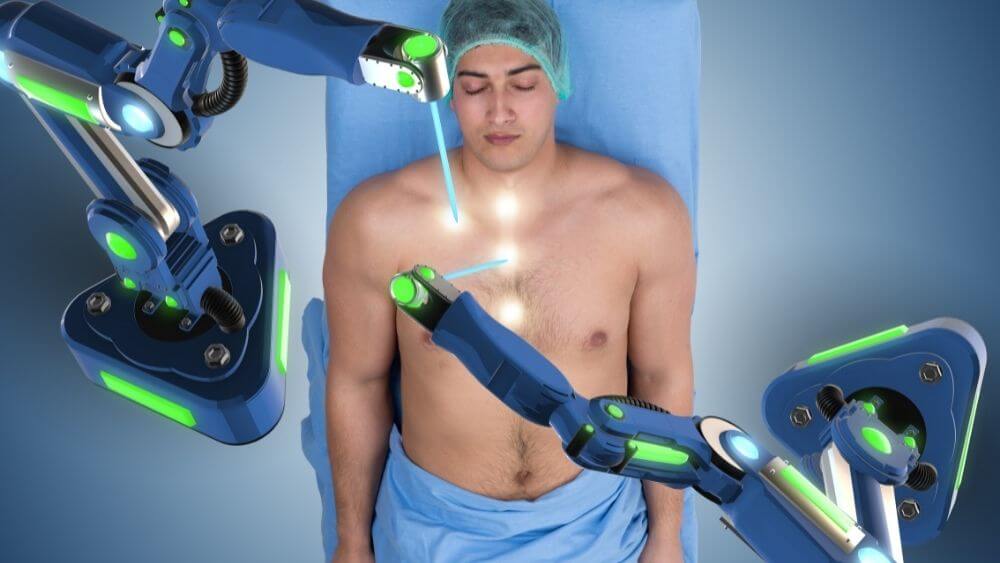Can robots perform surgery?

Welcome to the new age docs!
Clearly, the marvels of science have reached every corner of the earth at high speed. It is indeed splendid to realise that science with its advancements has made difficult tasks of life entirely simple, with greater chances of success. Seldom is a field in human life which has not benefitted from scientific developments.
As we say this, it’s time for us to focus on one of the most sought after medical field which has single-handedly been supervised and assisted by the boon of new-age scientific advancements.
Being the most valuable domain of every nation, the medical field needs constant attention and is always to be kept upgraded so as to ensure that only the absolute best for the patients. There is no slight chance of negligence that can be undertaken in this field, and so every measure is taken to ensure that with the change of times, only the best practices are performed.
In recent times, this advancement of technological use in the medical field has surely taken a giant leap, with the introduction of Robots as new-age doctors performing surgeries.
Surprised? Well, read more to find out!
Contents
Understanding Robots
Many of us can recount our childhood with experiences of having played with Robots. These metallic, battery-driven, human-like structures were one of the most cherished possessions a child could boast of. These would walk and perform actions themselves, making mechanical sounds with their moves! Even some of the famous cartoons of those times spoke of robots who performed heroic actions and saved lives. Weren’t they just simply wonderful?!
However, the type of robots we wish to speak about here is quite unlike those playful, fantastical creations that marked our childhood.
A robot at its very core can be defined as a ‘machine’ that is completely controlled by a computer device. Robots are capable of carrying out a complex set of actions easily within a significantly less amount of time, and that too automatically. It simply does not require any manual help.
The controlling computer of a robot may either be externally placed or may be embedded inside the structure 0f the robot. Significantly, the branch of science and technology that deals with the study, design and production of robots is called ‘Robotics’.
Robots in the medical field
Robots in the medical field have undoubtedly brought in a paradigm shift across the entire scope of medical history. The massive positive response that has been received in using robots for performing surgeries is that these result in more precision enabled surgical procedures, along with minimal contact and chances of bleeding.
This technique that was first utilised in 1985, has now developed into the most common way of performing treatments such as those of laparoscopy, orthopaedic surgeries, neurosurgery, etc.
The most commonly used, popular and successful model of robot system used all over the world for performing surgeries is known as the ‘da Vinci Surgical System’. What’s interesting about this model is that it can think for itself the modus operandi for performing the specific surgery, keeping in mind all the requisite details of the patient. The system uses its robotic arms to perform the operation, which is also remotely controlled by the doctors themselves.
How are Robots better than human doctors?
Firstly, there can be no comparison between a robot and a human doctor performing surgeries, since it is the human doctors who always supervise the entire robot-operated surgical procedure. However, with the demand for robot-driven surgeries in many hospitals and medical institutions across the world, there are some benefits of using a robot for performing critical surgeries.
Robot arms are capable of making smaller, and more careful precise incisions than human doctors, blocking out all possible chances of excessive bleeding of the patient. Moreover, the operating ties are speedier than before, making the entire process have a higher success rate.
Keyhole Surgery/micro-surgery
A category of robot oriented surgery itself involves the robotic arms to make the most minute hole in the affected area of the patient’s body. This is known as keyhole surgery or microsurgery. Thereafter surgical tubes are inserted through it; along with a micro camera and light tube, which then assists the surgeon to carry out the operation.
Some Related Questions
- Is there a future possibility, that may eliminate even the minute human assistance in making the robots perform surgeries?
- What are the other industries which have benefitted from robotic help?
- Can the robots assisting in the medical field, use social feelings as real-life doctors, to understand the patient’s case more diligently?
Fun Facts
- Certain forms of robots are also used as a form of exoskeleton/prosthetics, for assisting people who have nerve and muscle damage!
- There also exist certain kinds of robots, known as ‘Home Robots’, which can assist human beings in doing simple house chores!
Practice Time!
Here are some questions you’d like to answer to test your knowledge
The branch of science dealing with Robots is called:
- Robot study
- Robomatics
- Robotics
- Robology
The most popular model of robot system for surgeries is called:
- da Vinci System
- Robotic System
- Minute Operating Device
- None of the above
Are robots enabled with maximum precision to carry out surgeries?
- Doubtful
- Yes
- No
Key Hole surgery ensures:
- Minimum pain
- Less bleeding
- High success rate
- All of the above
Robotic surgery was used for the first time in the year:
- 2001
- 2010
- 1985
- 1990
State True Or False
- Robotic surgery is impossible: ________
- da Vinci is the name of a robotic surgery equipment: _______
- Robotic arms are incapable of precision in surgeries: __________
- Robot-enabled surgery requires minimum manual help: _________
- Robot is not a kind of machine: ________






Responses